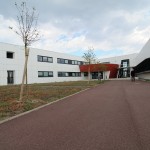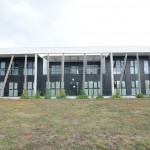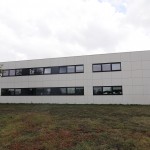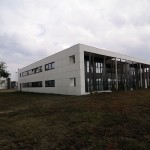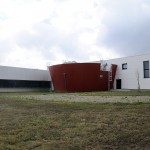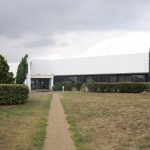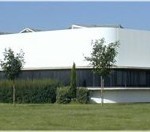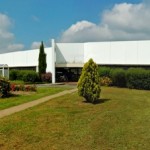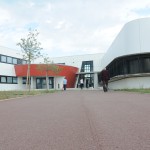Cerfacs
Digital simulation using High-Performance Computing (HPC) is a major challenge for companies and research organisations. The Centre Européen de Recherche et de Formation Avancée en Calcul Scientifique (Cerfacs) has had this in its DNA for over 35 years.
Cerfacs, which became an SAS in January 2021, is a centre for research, development, transfer and training in simulation, modelling and high-performance computing, mainly for the benefit of its industrial and public sector partners: Airbus Group, Cnes, EDF, Météo France, Onera, Safran and TotalEnergies. It is also associated with partners like CNRS (Joint Research Unit), Inria (joint laboratory with Airbus), CEA and IMFT (cooperation agreements).
– Cerfacs designs, develops and offers innovative software methods and solutions in the fields of aeronautics, space, climate, the environment and energy.
– Cerfacs is training students, researchers and engineers in the field of simulation and high-performance computing.
A little background:
The idea of the pioneers, at the forefront of whom were Jean-Claude André, Joseph Noailles, Jean-Paul Zahn, Jean-Marc Thomas, Pierrre-Henri Cros and a few others, was to prevent France and Europe, in the early 1980s, from experiencing the same difficulties as those experienced a few years earlier, when young researchers had to leave for the United States to gain access to intensive computing, this brand new discipline, which was not even called that, and which in fact did not even have a name, a new discipline that had emerged with the new vector computers and with the Cray computers. Parallel computing was just around the corner, and it was vital to launch initiatives to meet this challenge.
Cerfacs was created for 5 years (decree of 22/08/88, published in the JO of 06/11/88) in the form of a GIP (Groupement d’Intérêt Public) with 10 members: Aérospatiale, Cnes, CNRS, INPT, Inria, Matra-Marconi-Space, Direction de la Météorologie Nationale, Onera, Région Midi-Pyrénées, Université Paul Sabatier. It followed on from a Scientific Grouping set up on 13/02/87 involving the same members, plus INSA Toulouse. When it was extended from 6/11/93 (decree of 19/10/94, published in the JO of 27/10/94), CNRS and ONERA withdrew, leaving room for the arrival of CEA. At the request of the Ministry of Research, Cerfacs was then forced to abandon its GIP structure, and was transformed into a Société Civile, a structure governed by private law but with a civilian objective (research). The non-trading company, headed by Jean-Claude André, was set up on 01/04/96, with 3 historical partners of the GIP (Aérospatiale, which became EADS and then Airbus, the Cnes (EPIC), Météo-France (EPA)) and a new non-toulousain player, EDF.
3 new partners then joined Cerfacs: Safran in 2004, Onera (EPIC) in 2006 and Total in 2008.
Following Jean-Claude André’s retirement in 2010, Cerfacs was headed by Bijan Mohammadi for 3 years, and since October 2013 by Catherine Lambert.
The first scientific work …
The first researchers were recruited at the start of the 1987 academic year and moved into premises loaned by the Ecole Nationale de la Météorologie (ENM). This class consisted of 14 researchers, doctoral students and post-doctoral researchers, recruited to work on one of the first 3 subjects selected: parallel algorithms, turbulence and aerodynamics. Another class of 7 researchers followed a year later, then others… The scientific work progressed steadily, under the leadership of successive directors, Jean-Paul Zahn, Jean-Claude Ippolito, Joseph Noailles and Roland Glowinski, and Cerfacs moved forward very quickly, with the help of Jacques-Louis Lions, of course, who pushed with all his might and immense talent, with Cnes, with the Académie des Sciences and with the Collège de France.
From the outset, Cerfacs has had a Scientific Council made up of 15 international scientists. It has been chaired by Jean-François Minster, Sébastien Candel and now Jean-Yves Berthou.
and its own premises!
Cerfacs was in fact the Meteopole’s first external partner. A plot of land was granted on an emphyteutic lease at the end of 1989, and the first CERFACS building sprang up without delay, opening to its occupants at the start of the 1991 academic year, with a second building added in 2011.
Cerfacs today
Cerfacs is now well established on the national and international scene. It is associated with the CNRS the IRD in a joint research unit on the environment and climate (UMR CECI) and with Inria and Airbus in a joint team (CONCACE) aimed at developing a new approach to high-performance computing. It has a long-term scientific relationship with the CEA and IRIT.
The aim is clearly defined, stabilised and stated: to develop and improve methods for numerical simulation and advanced scientific computing on different supercomputer architectures, both for major problems in fundamental or more applied research, and for applications in major industrial fields.
Cerfacs has a staff of around 170 (including 123 employees) and an annual budget of €10m. Cerfacs brings together physicists, mathematicians, computer scientists, digital scientists and data scientists in an interdisciplinary way:
– with different nationalities: 11% of our researchers are non-French Europeans and 10% are non-Europeans.
– with different backgrounds: 50% of our doctoral students come from leading engineering schools (X, Centrale, ISAE, Insa, INPT/Enseeiht, etc.), and 50% from French or European universities.
– and 20% of our researchers are women.
Our 2023-2027 strategic research plan is based on a core of strategic activities:
- numerical algorithms: hollow linear algebra, finite elements and discretisation, optimisation and numerical approaches applied to computational fluid mechanics,
- data-based modelling with uncertainty quantification, data assimilation and physics-based artificial intelligence.
- sustainable programming with optimisation of our codes, quantum computing, code coupling and management of large quantities of data.
Controlling the size and complexity of calculations and data, and the energy consumed by infrastructures – major concerns in HPC – are also at the heart of Cerfacs’ scientific challenges.
These strategic areas are fuelled by applications in order to :
- Simulate propulsion systems: to optimise the design of engines for aeroplanes, helicopters, launchers and satellites, in order to reduce design times in the aeronautics and space industries.
- Model aerodynamics and aeroacoustics
- Simulate energy production using hydrogen and alternative fuels, with safety challenges
- A better understanding of climate variability and predictability
- Better assess the impact of natural hazards, such as flooding (using in situ and spatial data),
- A better understanding of the impact of aeronautics on the environment and the impact of global warming on aeronautics.
Key dates
| 1987 | Creation of a Cerfacs Scientific Group with 11 members : Aérospatiale, Cnes, CNRS, INPT, Inria, Insa, Matra-Marconi Space, Météo-France, Onera, Midi-Pyrénées. |
| 1988 | Cerfacs becomes a public benefit corporation |
| 1996 | Cerfacs becomes a civil society with four associated structures : Aérospatiale, later becoming EADS, then Airbus Group, Cnes, Météo-France and EDF. |
| 1999 | Creation of the Cerfacs-CNRS associated research unit, the Sciences de l' Univers at Cerfacs (Ura 1875) collaboration agreement with CEA in the field of advanced computing methods |
| 2004 | Safran becomes a new Cerfacs' partner |
| 2006 | Onera becomes a new Cerfacs' partner |
| 2008 | Total becomes a new Cerfacs' partner |
| 2009 | Creation of a joint Inria / Cerfacs laboratory |
| 2013 | Cooperation agreement Inria / Cerfacs |
| 2015 | The tenth computer set at Cerfacs since 1996 occupies the 388° place in the top 500 delivering a peak power of 242 Tflop/s |
| 2015 | Creation of the CECI joint research unit, as an extension of URA 1875, associated with the CNRS. |
| 2021 | Cerfacs becomes a “société par actions simplifiée” with seven associated structures : Airbus, Cnes, EDF, Météo-France, Onera, Safran et TotalEnergies. |
| 2022 | Creation of a joint team INRIA-Airbus-Cerfacs called CONCACE. |
Cerfacs aims to
- Develop scientific and technical researches in order to improve advanced computing methods, including a better consideration of the related physical processes as well as the development of performing algorithms for the new computers' architectures,
- Allow either solely or shared access to computers with new architecture, being able to gain performances,
- Transfer this scientific knowledge and technical methods for application to big industrial sectors,
- Train high qualified people and offer an advanced training for the fields and selected application themes.

